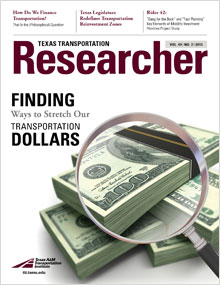In the early 20th century, the internal combustion engine replaced the horse as the primary technology driving commuter transportation. Enthusiasts hailed the enhanced economic opportunity promised by the multi-horsepower automobile and the prospect of less manure in the streets (a huge disease-breeding problem at the time).
But dependency on the automobile created its own problems: urban sprawl, smoggy cities and a constant need to expand roadway capacity. “Before long, everything related to transportation had to accommodate the internal combustion engine,” says Dave Ellis, research scientist and manager of the Texas A&M Transportation Institute’s (TTI’s) Infrastructure Investment Analysis Program. “Roads needed paving. Gasoline needed refining. The Age of the Automobile was born.”
Lawmakers of the time created the gas tax, a fee paid on every gallon of gasoline, to fund the maintenance and expansion of the nation’s transportation infrastructure. And that worked… for a while. Innovations in technology — like electric, hydrogen-fueled and hybrid cars — and improved gas mileage have resulted in flat gas-tax revenues.

At the same time, demands on the transportation network have continued to rise. According to the Texas 2030 Committee, over the next 25 years the Lone Star State faces a $170 billion gap between projected public revenues and infrastructure improvement needs. Without that revenue, Texans will have to accept a substandard transportation system.
With that as context, TTI conducted Project 6-0700: Innovative Finance for the Texas Department of Transportation (TxDOT). “We captured the different ways Texas has financed transportation in the past to identify prevailing ‘funding philosophies,’ ” says Ellis. “Once we understand what the pieces of the puzzle are, we can better determine how to fit them together.”
The puzzle Ellis refers to forms a matrix of finance principles and strategies. Within those categories, specific funding approaches — toll road-user fees versus vehicle registration fees, for example — can be mapped and classified. “The matrix was developed by three researchers at TTI — Trey Baker, Jason Wagner and Nick Norboge — and became the key to the project. These guys did a great job capturing the transition from one funding philosophy to another,” explains Ellis. “Historically, the approach has been ‘public funding for the public good.’ Recently, we’ve seen more public-private sector partnerships in applications like toll roads.”
Looking at trends identified in the input philosophies matrix, the obvious question is: does increasing a dependence on the private sector mean less of an emphasis on “the public good”?
“Not necessarily,” states Ellis. “If I own a company that builds and maintains a toll road, it’s in my best interests to make it the best-maintained road possible for commuters and freight carriers, who depend on it to move their goods efficiently. To be profitable, a roadway becomes like any product: customer driven. In this case, literally.”
Like 100 years ago, the game is changing again, Ellis says. That’s partly due to technology, as when the automobile supplanted the horse, but also due to rising costs and demands on the transportation network. With the matrix, state transportation planners and lawmakers can better understand the different funding approaches and focus whatever philosophical approach they choose more efficiently.

